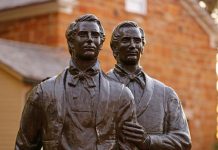
On August 15, 1840, Joseph Smith revealed a doctrine that is so fundamental to our beliefs that we hardly think twice about it — but to the brand-new Saints, it was life-changing: baptisms for the dead.
The Church’s website explains:
“On August 15, 1840, shortly after the Saints moved to the future site of Nauvoo, Illinois, Joseph Smith preached a sermon at the funeral of Church member Seymour Brunson. Noticing a woman in attendance who had lost her son before he could be baptized, Joseph revealed that the Saints ‘could now act for their friends who had departed this life’ by being baptized in their behalf. He cited the ancient Apostle Paul’s teachings regarding baptism for the dead and encouraged the Saints to rejoice ‘that the plan of salvation was calculated to save all who were willing to obey the requirements of the law of God.‘”
The Saints were, of course, elated. While so many of us have had this knowledge our whole lives or since we were introduced to the Church, the early Saints were unsure of the fate of their deceased loved ones — so this revelation was a godsend, to say the least.
Joseph Smith had certainly dealt with the pain of wondering where a loved one would go after their death. Joseph’s oldest brother, Alvin, had become suddenly ill and died when he was 25 years old, leaving the whole Smith family utterly devastated. That devastation was only compounded, unfortunately, by a preacher’s words at Alvin’s funeral:
“When Alvin died, the family asked a Presbyterian minister in Palmyra, New York, to officiate at his funeral. As Alvin had not been a member of the minister’s congregation, the clergyman asserted in his sermon that Alvin could not be saved. William Smith, Joseph’s younger brother, recalled: “[The minister] … intimated very strongly that [Alvin] had gone to hell, for Alvin was not a church member, but he was a good boy and my father did not like it.”
That experience obviously deeply impacted Joseph, because when he later received a vision of the celestial kingdom, he was surprised to see Alvin there.
“In January 1836, many years after Alvin’s death, Joseph Smith received a vision of the celestial kingdom, in which he saw that Alvin, as well as his mother and father, would someday inherit that kingdom. Joseph ‘marveled how it was that [Alvin] had obtained an inheritance in that kingdom, seeing that he had departed this life before the Lord had set his hand to gather Israel the second time, and had not been baptized for the remission of sins’ (D&C 137:6).”
Thankfully, God cares deeply about each of His children and will give them all a fair and equal chance to return to live with Him. Because of this, we are blessed with doctrines like baptism for the dead.
As with many revelations, Joseph didn’t have all the details about baptisms for the dead when the doctrine was first revealed (revelation and associated details often come line upon line) — so the Saints initially performed these proxy baptisms a little differently than we do today.
Almost immediately after the doctrine was revealed, the Saints began performing baptisms in nearby rivers and streams for friends, family members, and well-known figures. Saints were being baptized for anyone — men for women and women for men — unlike today’s proxy baptisms, which are according to gender (i.e., women are baptized only for women, and men only for men).
Attorney and author of Wilford Woodruff’s Witness: The Development of Temple Doctrine, Jennifer Mackley, talked about the evolution of the Saint’s understanding in regards to baptisms for the dead in an episode of the popular Latter-day Saint podcast LDS Perspectives:
“Women were being baptized for men, and men for women. Again, they didn’t have detailed instructions. So then there was revelation that the witnesses had to be there to make sure that the instructions were being followed. They had never done this before.”
The Saints learned more about proxy baptisms as time went on. Early in 1841, Joseph Smith received further revelation that baptisms for the dead were to be performed in temples. Later, they were told to keep a careful record of each proxy baptism. Then, a few years after that, they were informed that baptisms needed to be performed according to gender.
Revelation came “here a little and there a little,” and now, nearly 180 years later, we continue to benefit from the beautiful revelation of baptisms for the dead and from the Saints’ desire to share the gospel with people on both sides of the veil.





